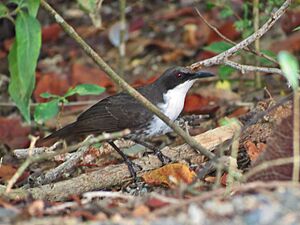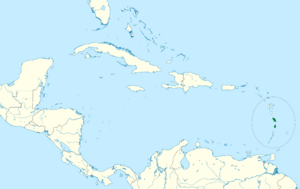White-breasted thrasher facts for kids
Quick facts for kids White-breasted thrasher |
|
|---|---|
 |
|
| In Martinique | |
| Conservation status | |
| Scientific classification | |
| Genus: |
Ramphocinclus
|
| Species: |
brachyurus
|
 |
|
The white-breasted thrasher (Ramphocinclus brachyurus) is a special type of bird. It belongs to the Mimidae family, known for birds that often mimic other sounds. This bird is quite curious and can be noisy. If disturbed, it might make warning sounds and move around a lot.
This thrasher lives only on two islands: Martinique and Saint Lucia. These islands are part of the Lesser Antilles in the Caribbean. Because it lives in such a small area, the white-breasted thrasher is considered an endangered species. This means its numbers are low, and it needs protection.
Contents
What Does It Look Like?
The white-breasted thrasher is a medium-sized bird. It is usually about 23 to 25 centimeters (9 to 10 inches) long. It weighs between 48 and 60 grams, which is about the same as a small apple.
Adult thrashers have dark brown feathers on their back and wings. Their throat, chest, and belly are bright white. They have a long, dark beak that curves down a little at the end. Around their red eyes and nostrils, they have small, dark bristles. This bird has strong black legs and can live for 7 to 8 years.
It's hard to tell male and female thrashers apart just by looking at them. They are the same size and have the same colors. Only during breeding season can you sometimes tell a female by a special patch on her belly.
Young thrashers look a bit different. Their feathers are all brown, with a brown throat and a grayish belly. The white patch on their chest grows in when they are about a month old. In their first year, young birds have rusty brown upper parts and brownish eyes.
Different Types of Thrashers
The white-breasted thrasher is the only bird in its group, called Ramphocinclus. This means it's quite unique!
There are two known types, or subspecies, of the white-breasted thrasher:
- Ramphocinclus brachyurus brachyurus
- Ramphocinclus brachyurus sanctaeluciae
Each type lives on a different island. They also look a little different. The R. b. sanctaeluciae type is bigger and darker than the R. b. brachyurus type.
Where Do They Live?
Their Home Islands
The white-breasted thrasher lives only on Martinique and Saint Lucia. This small home range makes it harder for the species to survive.
The R. b. brachyurus type lives only in Martinique. Its home is a small, protected area called the Caravelle Peninsula. This area is only about 5 square kilometers (2 square miles).
The R. b. sanctaeluciae type lives in Saint Lucia, which is south of Martinique. On Saint Lucia, there are two groups of these birds. One lives in the north, and the other lives in the south. There is no sign that these birds travel between the two islands.
What Kind of Habitat Do They Like?
White-breasted thrashers prefer dry tropical forests and bushy areas. However, the northern group in Saint Lucia also lives near ravines and river valleys.
These birds are picky about where they live. They like semi-wooded areas close to the coast, usually within 2 kilometers (1.2 miles) of the sea. They also prefer places up to 200 meters (650 feet) above sea level. They avoid open spaces and areas with short bushes. This is because they are safer from predators in thicker areas, especially when raising their young. They also like soils with lots of fallen leaves, which helps them find food.
How They Live
What Do They Eat?
The white-breasted thrasher eats different kinds of food. They eat both insects and fruits. What they eat depends on what food is available.
These birds mostly find their food on the ground. They search through fallen leaves for insects and berries. They can also spit out seeds from whole berries to save them for later.
Who Are Their Enemies?
Since white-breasted thrashers find food on the ground, they can be attacked by small animals. Their eggs are also often eaten by predators. The types of predators are different on each island.
On Saint Lucia, their predators include boa constrictors (a type of snake), opossums, and broad-winged hawks. On Martinique, their enemies are rats, small Asian mongooses (an animal brought to the island), and cats.
How Do They Communicate?
White-breasted thrashers don't have a very wide range of calls, which is a bit unusual for birds in the Mimid family. They often make short, harsh sounds. Sometimes, they make a musical "tee-rou" sound.
They use alarm calls to warn each other about danger. On Saint Lucia, the alarm call is a harsh "tschh." On Martinique, it's a "grok grok." Young thrashers make thin "tseep" calls.
Life Cycle and Reproduction
The white-breasted thrasher's breeding season starts in mid-April and lasts until the end of September. A pair of birds can have up to four groups of young in one season. They usually lay 1 to 3 eggs at a time.
These birds often live in pairs. They build large nests high up in trees, usually 1.5 to 5 meters (5 to 16 feet) above the ground. Before using a nest, a pair might build several. Both birds help build the nest. They take turns sitting in the nest to shape the inside. Because they work together, they are called cooperative breeders.
Many eggs are eaten by predators. To protect their nests, thrashers keep them very clean. They remove eggshells and waste. This makes it harder for predators to find the nest.
Protecting the White-breasted Thrasher
There are about 1900 white-breasted thrashers left in the world. Because of this low number, they are listed as "endangered" by the IUCN Red List. This means they are at high risk of disappearing forever.
Their numbers have dropped a lot because their homes are being destroyed on both islands. While thrashers can live alongside some predators like rats and mongooses, these animals still cause problems. This is especially true in Martinique, where there are more rats and mongooses.
To help these birds, groups that protect nature have started programs. These include getting rid of rats and catching mongooses. They also have a program to watch how well the R. b. brachyurus type reproduces. One part of this program involves putting plastic bottles on tree trunks where nests are. This stops predators from climbing up and reaching the nests.


